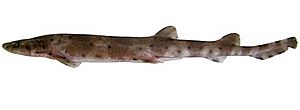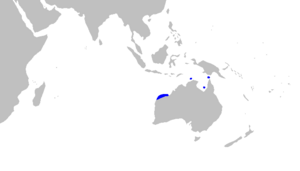Banded sand catshark facts for kids
Quick facts for kids Banded sand catshark |
|
|---|---|
 |
|
| Conservation status | |
| Scientific classification | |
| Genus: |
Atelomycterus
|
| Species: |
fasciatus
|
 |
|
The banded sand catshark (Atelomycterus fasciatus) is a type of small shark. It belongs to the catshark family, called Scyliorhinidae. This shark lives in the warm waters of the Indo-West Pacific Ocean. You can find it mainly off the coast of northern Australia.
These sharks live in fairly deep water. They are usually found between 27 and 120 meters (about 90 to 390 feet) below the surface. They are not very big, growing up to about 45 centimeters (18 inches) long.
Contents
What is a Catshark?
Catsharks are a large group of sharks. They get their name because their eyes often look like a cat's eyes. Most catsharks are small to medium-sized. They usually live near the bottom of the ocean.
Features of Catsharks
Catsharks have a few common features. They have two small dorsal fins (fins on their back). These fins are usually placed far back on their body. They also have a long, slender body. Many catsharks have rough skin, like sandpaper. This is because of tiny tooth-like scales called dermal denticles.
What Does the Banded Sand Catshark Look Like?
The banded sand catshark has a unique appearance. It has a slender body, typical of catsharks. Its skin is covered in small, rough denticles.
Color and Markings
This shark is named for the dark bands on its body. These bands help it blend in with its surroundings. The colors can vary, but they usually have a light background with darker stripes or spots. This camouflage helps them hide from both predators and prey.
Where Do They Live?
The banded sand catshark is found only in a specific area. This area is called endemic to northern Australia. It lives in the tropical waters off the northern coast.
Specific Habitat
These sharks prefer the sandy or muddy bottoms of the ocean. They are often found on the continental shelf. This is the underwater landmass that extends from a continent. They live in depths where the water is not too cold or too warm. The area they inhabit is between 10° S and 21° S latitude.
What Do They Eat?
Like most sharks, the banded sand catshark is a predator. It hunts for food on the ocean floor. Their diet helps keep the ocean ecosystem balanced.
Hunting Habits
They likely feed on small bottom-dwelling creatures. This can include small fish, crabs, and other invertebrates. They use their sense of smell and special sensors to find prey in the dark depths.
How Do They Reproduce?
Banded sand catsharks reproduce by laying eggs. This is different from some other sharks that give birth to live young.
Egg Cases
Female catsharks lay eggs in protective cases. These cases are often called "mermaid's purses." The egg cases protect the developing shark embryo. They are usually attached to seaweed or rocks on the ocean floor. The young sharks hatch from these cases when they are ready.
Conservation Status
The conservation status of an animal tells us if it is at risk. The banded sand catshark is listed as "Least Concern" (LC) by the IUCN.
Why "Least Concern"?
This means that its population is currently stable. It is not considered to be in danger of extinction. However, it's always important to monitor marine life. This helps ensure they remain healthy in the future.
See also
 In Spanish: Atelomycterus fasciatus para niños
In Spanish: Atelomycterus fasciatus para niños


